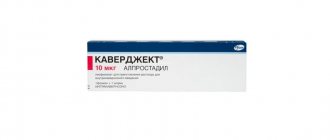Write a review
Reviews: 0
Manufacturers: Balkanpharma-Dupnitza (Bulgaria)
Active ingredients
- Codeine
- Caffeine
- Metamizole sodium
- Paracetamol
- Phenobarbital
Disease class
- Phantom limb syndrome with pain
- Acute upper respiratory tract infection of multiple and unspecified localization
- Sciatica
- Myalgia
- Neuralgia and neuritis, unspecified
- Fever of unknown origin
- Headache
- Other constant pain
- Surgical practice
- Dysmenorrhea, unspecified
Clinical and pharmacological group
- Not indicated. See instructions
Pharmacological action
- Anti-inflammatory
- Antipyretic
- Sedative
- Analgesic (non-narcotic)
Pharmacological group
- NSAIDs - Pyrazolones in combinations
- Opioid narcotic analgesics in combinations
pharmachologic effect
The tablets have a combined composition and have antipyretic, analgesic, antimigraine and vasodilating effects. The medication is able to eliminate the symptoms of influenza , acute respiratory infections, and colds.
Caffeine stimulates brain activity, in particular psychomotor centers. The active substance increases performance (mental and physical), reduces the severity of feelings of fatigue and drowsiness , has an analeptic effect, and enhances the effect of analgesics.
Codeine has an analgesic effect by changing the emotional perception of pain, which is achieved by stimulating the antinociceptive system. Suppression of the excitability of the cough center provides an antitussive effect of central origin. Compared to Morphine, the active component is less likely to cause respiratory depression, nausea, miosis, and constipation (when opioid receptors are activated in the intestinal lumen, smooth muscle tissue relaxes, sphincter spasm decreases, and peristalsis decreases). Codeine can enhance the effect of analgesics.
Paracetamol is a non-narcotic analgesic. The mechanism of action is based on blocking cyclooxygenases-1,2 in the nervous system. The antipyretic and analgesic effect is achieved by influencing the centers of thermoregulation and pain.
Metamizole Na belongs to the group of NSAIDs. It has antipyretic and analgesic effects. An antispasmodic effect is observed on the smooth muscles of the biliary and urinary tract.
Phenobarbital has sedative, antiepileptic, muscle relaxant and hypnotic effects.
Side effects
allergic responses , thrombocytopenia (decreased number of blood cells - platelets ), dizziness are rarely observed . With long-term therapy, pathology of the kidneys and renal system may develop, and bronchial asthma attacks may become more frequent. When the medication is abruptly discontinued, withdrawal symptoms are recorded, manifested mainly by headaches . Long-term use may be accompanied by a gradual decrease in the effectiveness of the drug.
Nervous system:
- irritability;
- limb tremors;
- headache;
- fast fatiguability;
- anxiety;
- impaired coordination of movements.
The cardiovascular system:
- agranulocytosis;
- extrasystole;
- arterial hypotension;
- cardiopalmus;
- hemolytic anemia.
Digestive tract:
- constipation;
- epigastric pain;
- vomit;
- anorexia;
- dry mouth;
- diarrhea syndrome;
- changes in liver function.
Bronchospasm is rarely observed. If other negative reactions are registered, consultation with a doctor and independent discontinuation of the drug Sedalgin is required.
Indications and restrictions
The drug is indicated for painful sensations of any location and intensity. This remedy relieves symptoms such as:
fever, including ARVI;- arthralgia;
- dysmenorrhea;
- myalgia;
- neuralgia;
- sciatica;
- various types of pain (burn, traumatic, dental, rheumatic, migraine).
However, against the background of the positive dynamics of the drug’s effect on the body, there are a number of contraindications that must be taken into account when prescribing tablets:
- pregnancy;
- breastfeeding the baby;
- myocardial infarction;
- children under 12 years of age;
- hypersensitivity or intolerance to any substance included in the medication;
- renal or liver failure;
anemia;- arrhythmia;
- leukopenia;
- glaucoma;
- bronchial asthma;
- hypertension (intracranial);
- depressed breathing;
- alcohol intoxication.
This medication is prescribed with extreme caution to elderly patients, as well as people with gastric or duodenal ulcers. Considering these contraindications, you should not use Sedalgin Neo without the prescription of a specialist, much less self-medicate.
Interaction
Anxiolytics, sedatives and all medications that depress the functioning of the nervous system can lead to increased sedative effect of Sedalgin Neo and depression of the respiratory center (a life-threatening condition). The drug enhances the effect of alcohol-containing drinks on psychomotor reactions. Metamizole displaces hypoglycemic drugs, indirect anticoagulants, indomethacin, and glucocorticosteroids from binding to proteins, increasing their activity. Oral contraceptives , antidepressants and Allopurinol increase the toxicity of Metamizole Na by changing its metabolism in the hepatic system. The effect of the active component is reduced when taking inducers of microsomal liver enzymes. An increase in toxic effect is observed during treatment with other non-narcotic analgesics.
General information
The drug is prescribed by specialists from medical institutions for frequent pain, fever, flu, severe and prolonged cough. It has proven itself well as an analgesic, antipyretic, and sedative. But due to its strong effect, the medicine is not recommended for use in children under twelve years of age, as well as in pregnant and breastfeeding women, since it contains phenobarbital, which negatively affects the condition of the fetus and the child’s body.
Drug group, INN
Sedalgin Neo belongs to the combined analgesic drugs with the international nonproprietary name Codeine + Caffeine + Metamizole sodium + Paracetamol + Phenobarbital. Finds its application when:
- neuralgia;
- frequent migraines;
- neuritis;
- colds (flu, ARVI), accompanied by acute attacks of coughing, high fever;
- various types of pain (dental, migraine, postoperative), trauma, rheumatism, burns;
- dysmenorrhea.
Analogs
Level 4 ATC code matches:
Phenacetin
Combiflu
Chlorphenamine
Coldflu
Calpol
Fervex
Panadol Extra
Panadol for children
Panadol
Solpadeine
Efferalgan
Milistan
Coldrex Maxgripp
Coldrex Hotrem
Coldrex
AntiGrippin
Unispaz
Pentalgin Plus
Rapidol
Maxicold
- Sedal-M;
- Quintalgin;
- Santoperalgin.
Sedalgin-Neo
Active substance:
Codeine, Caffeine, Metamizole sodium*, Paracetamol*, Phenobarbital*
Pharmgroup:
Opioid narcotic analgesics in combinations
Analogs for the active substance:Pentalgin-ICN Pentalgin-MEZ Sedal-M | Application area:Abdominal surgery Adenomectomy Bacterial infections of the upper respiratory tract Bacterial respiratory infections Balloon coronary angioplasty Pain syndrome of non-rheumatic origin Pain syndrome with vertebrogenic lesions Pain syndrome in muscular and joint diseases Pain syndrome with neuralgia Pain syndrome with neuralgia Pain syndrome from burns Pain syndrome due to smooth muscle spasms Pain syndrome due to smooth muscle spasms (renal and biliary colic, intestinal spasms, dysmenorrhea) Pain syndrome due to spasms of smooth muscles of internal organs Pain syndrome due to spasms of smooth muscles of internal organs (renal and biliary colic, intestinal spasms, dysmenorrhea) Pain syndrome in chronic inflammatory diseases of the musculoskeletal system Pain syndrome is mild or moderate Pain in the muscles Pain during menstruation Pain syndromes in dental practice Muscle soreness Muscle soreness during heavy physical activity Painful, irregular periods Painful conditions of the musculoskeletal system Vaginal hysterectomy Corona bypass Pain in the musculoskeletal system Muscle pain Pain at rest Dentin pain Muscle pain Pain during menstruation Pain during menstruation Viral respiratory disease Pain due to colds Viral respiratory tract infections Pulp pain Muscle pain Interventions on the vagina and cervix Bladder interventions Intervention in the oral cavity Musculoskeletal pain Pain after tartar removal Pain after dental procedures Pain in infectious and inflammatory diseases of the upper respiratory tract Pain during tooth extraction Phantom pain Inflammatory disease of the upper respiratory tract Inflammatory diseases of the upper respiratory tract Inflammatory diseases of the upper respiratory tract with difficult to separate sputum Inflammatory diseases of the respiratory tract Restorative and reconstructive operations Secondary infections with influenza Secondary infections due to colds Hand hygiene of medical personnel Gynecological surgery Gynecological interventions Gynecological surgeries Hyperthermia malignant Hypovolemic shock during surgery Influenza conditions Disinfection of purulent wounds Disinfection of wound edges Dentin pain Diagnostic interventions Diagnostic procedures Diathermocoagulation of the cervix Dysalgomenorrhea Dysmenorrhea Dysmenorrhea (essential) (exfoliative) Long surgical operations Replacing fistula catheters Difficulty secreting sputum in acute and chronic respiratory diseases Occipital and intercostal neuralgia Malignant hyperthermia Toothache Upper respiratory tract infections Upper respiratory tract infections Respiratory tract infections Respiratory and lung infections ENT infections Infectious and inflammatory diseases of the upper respiratory tract Infectious and inflammatory diseases of the upper respiratory tract and ENT organs Infectious and inflammatory diseases of the upper respiratory tract in adults and children Infectious and inflammatory diseases of the upper respiratory tract Infectious inflammation of the respiratory tract Respiratory tract infection Infection during orthopedic surgery Artificial heart valve Sciatica Qatar of the upper respiratory tract |





